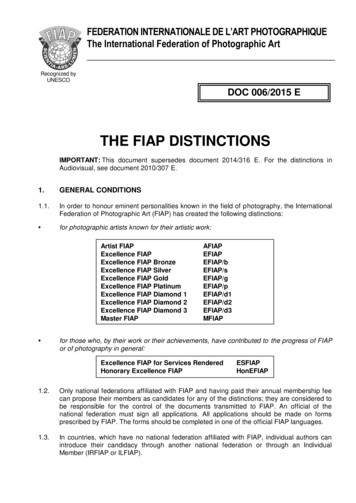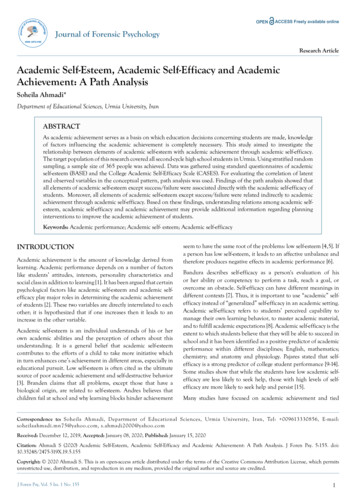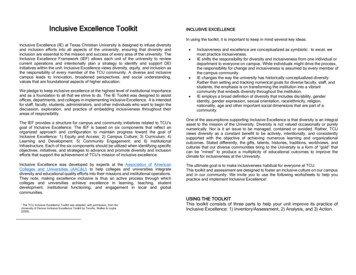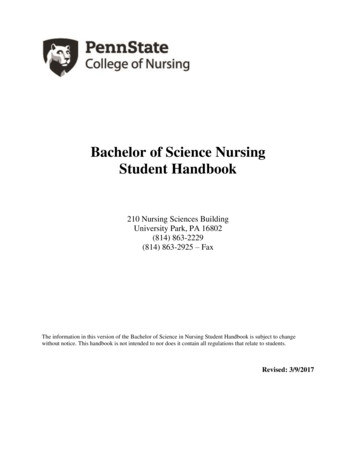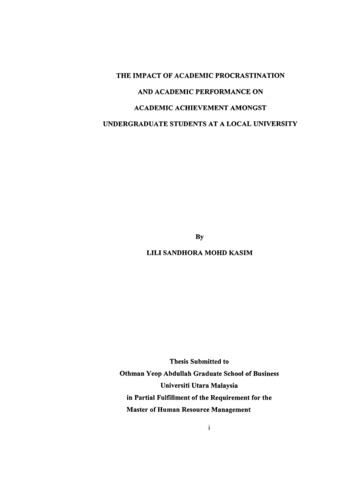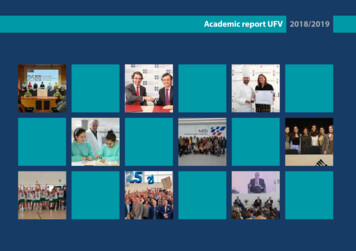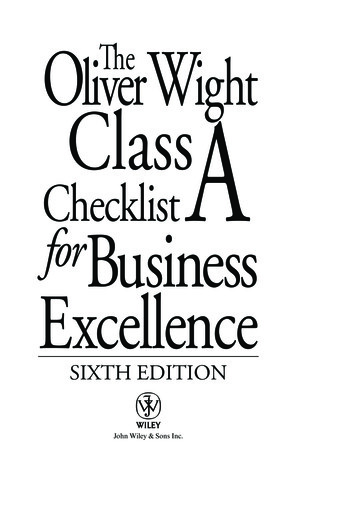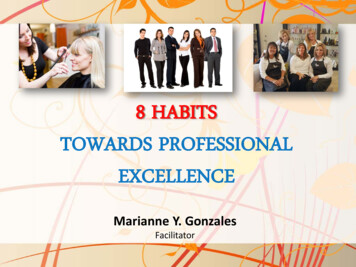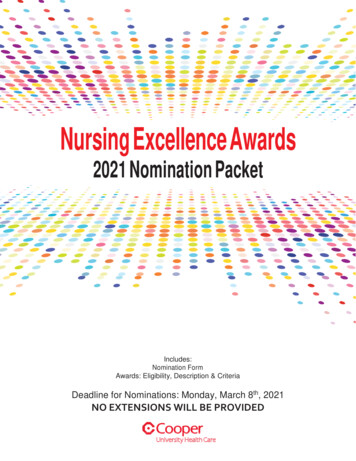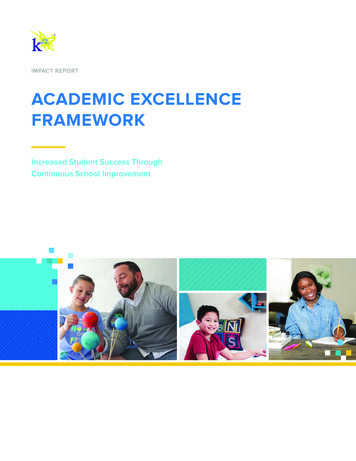
Transcription
IMPACT REPORTACADEMIC EXCELLENCEFRAMEWORKIncreased Student Success ThroughContinuous School Improvement
Impact ReportPLANNINGFOR SUCCESSAs more and more families seek educational choicesbeyond their neighborhood schools, it’s important thatthey have access to options that provide personalizedapproaches to meet their children’s unique needs. K12,a leader in online and blended learning, recognizedthe need to remove barriers to a great educationand committed to improve schools and drive studentsuccess. K12 researched the standards and bestpractices that guide high-performing schools anddeveloped a plan to replicate them. The goal was toincrease school performance and work to close theachievement gap between K12 partner schools andstate average performance on assessments by quicklypropelling student growth.In an effort to facilitate improvement, K12 developed theAcademic Excellence Framework (AEF). Serving a diverseset of schools and independent boards, K12 realizes that noone approach will work for all students at all schools. Justas students need a personalized approach to education, sodo schools. AEF is one of many programs K12 employs tosupport student achievement and school improvement.The AEF is designed to strengthen schools and improvestudent growth by: Developing comprehensive strategic plans Reinforcing school culture Utilizing data-driven instruction Establishing goals and measuring progress Holding schools, administrators, teachers, students,and families accountable for successThe AEF process enables each school to take advantageof the creativity and ideas of its own faculty and leadership,while scaling the best ideas that have advanced studentachievement across other schools. By articulating priorities,identifying challenges, establishing timelines, and settingmeasurable goals, the framework plan helps each schoolchart a path toward educational success.““Improving individual student achievement is the driving force behind everything we do at K12.The Academic Excellence Framework allows our educators to share their most creativethinking and innovations across our network of schools, and allows us to scale successfulapproaches quickly and effectively. Working with our school leaders, teachers, and parents,we are constantly innovating to solve problems at the student and school levels.”—Kevin P. Chavous, President of academics, policy and schools1
Impact ReportSEVEN GUIDING STANDARDSK12’s AEF is based on an examination of high-performing schools, combined with best practices and resources frommore than 70 K12-powered online schools. K12’s research identified seven primary principles involved in improvingstudent outcomes. The AEF centers on these principles and guides schools in developing comprehensive academicplans that are evaluated and enhanced on a continuing basis.ProfessionalDevelopmentObservation &FeedbackData-DrivenInstructionCulture7Seven principlesinvolved inimproving studentoutcomesInstructionAssessmentStaffingK12 provides each school with a dedicated team of education experts to support the development and execution of theframework. These resources include: Weekly school consultations Quarterly school reviews of key performance indicators Strategic action planning Measurement of program implementation Weekly tracking of school-level student outcomes through academic dashboards2
Impact ReportTHEFRAMEWORKIN ACTIONAt Arizona Virtual Academy (AZVA), the AEF is in full swing. Aspart of the planning process, AZVA leaders solicited feedbackfrom teachers and parents to guide cultural and academicchanges. The feedback informed the development of a new schoolmotto and academic requirements, including a new approach tohelp keep students accountable for their assignments.RAPID RESULTSThe changes AZVA implemented have already had a big impact on student results and culture at the school. They fullyimplemented the AEF standards in the 2016–2017 school year and within the first year students have already showntremendous growth and made great strides in increasing proficiency on state assessments.ENGLISH LANGUAGE ARTS8Closed12Point GAPProficiency growth from 2015–2016 to2016–2017 narrowed the gap betweenAZVA students and the state average toless than one percentage point—closinga 12-point gap in just one school year.13PercentagePointsPercentagePointsFor grades 9, 10, and 11, AZVA studentsactually surpassed the state average inproficiency achievement by an averageof 8 percentage points.The percentage of students achievingproficiency grew nearly 13 percentagepoints from 2015–2016 to 2016–2017,bringing the overall total to 38.2 percentin 2017.MATH10Points inAlgebra I2Points inGeometryAlgebra I and Geometry students at AZVAoutpaced the state proficiency average,with a 10 percentage point advantageover the state average in Algebra I andtwo percentage points over for Geometry.11Additional27%PercentagePointsmeeting proficiencyAlgebra I students showed the mostimprovement year over year, withan additional 27 percent meetingproficiency—overall, 49 percent ofAZVA Algebra I students achievedproficiency in 2017.The gap between AZVA studentachievement and the state average wascut in half in one year, to 10.7 percentagepoints behind the state average. Thepercentage of AZVA students achievingproficiency jumped nearly 11 percentagepoints to 28.6 percent in 2016–2017.““Throughout the year, our principals, teachers, and other administrators review school and student data and measure programsuccess or areas for improvement; we then refine our practices to best meet the needs of students we have at that point intime. Our overarching goal is to help our students master concepts and constantly improve.”—Dr. Kelly Van Sande, Head of School, Arizona Virtual Academy, Insight Academy of Arizona3
Impact ReportCONTINUOUSIMPROVEMENT JOURNEYK12 partner schools enroll a high percentage of newstudents each year compared to traditional schools,and these students are more likely to enter the schoolunprepared to learn at grade level. To help everystudent achieve his or her potential and increaseproficiency, K12 uses innovative, creative approachesto education that challenge the status quo and producepositive results.Formalizing this drive to constantly evaluate and improve isa key feature of the AEF. Each school must evaluate annuallythe outcomes and the plan’s implementation to determinewhether the academic achievement of all students improved,whether the goals and objectives contained in the plan wereachieved, and if the plan needs enhancement.This is an ongoing process as more schools implement andenhance the framework each year. K12 teams collaboratewith school leaders and provide support through ongoingconsultations, plan revisions, improvements, and professionaldevelopment. During an academic review, the schoolreceives feedback on each component. This includes a set ofrecommendations that are specific and relevant to meetingthe school’s academic goals. All data, plan iterations, andfeedback are completed during the summer transition so theframework and any enhancements can be implemented atthe start of the next school year.Identify &GatherMonitor &EvaluateResultsAnalyze DataImplementthe PlanPlan toImprove4
Impact ReportINCREASEDSTUDENT ENGAGEMENTAn essential part of the AEF is increasing the amount of time that teachersprovide direct instruction to students and ensuring those who need extrasupport in certain content areas are receiving it.Already the focus on direct instruction has had an impact on student engagement,with a 21 percent increase in student attendance and participation in direct instructionhours from the 2016–2017 school year to last year. Students have engaged in 2 millionmore hours of direct teacher instruction year over year across all K12 partner schools.21%increase in studentattendance and participationin direct instruction hours““K12 teachers are the backbone of our students’ educational success. That’s why a keyelement of the AEF is developing innovative ways for students and teachers to engage more.From increased direct instruction time and chat sessions to family phone calls, teachersare building strong relationships and gaining a better understanding of each student’sunique needs.”—Nate Davis, CEO and Chairman of the Board5
Impact ReportZEROING IN ON STUDENTS INNEED: THE RETEACH MODELOne innovation stemming from the AZVA reviews was the Reteach Model, which leverages individual data tohelp teachers identify students who have not mastered concepts and enable them to intervene immediately withadditional instruction in an effort to help improve outcomes and close achievement gaps.The results of this approach have been remarkable. Students who attend Reteachare improving their scores in follow-up assessments—some going from an F toan A. Students who already achieved a passing grade on the assessment arealso participating in Reteach, and their growth is typically smaller (one to twopercentage points on average). Each week, teachers collect student data, analyzeit to guide instruction, and identify students in need of additional support. They alsouse it to measure student learning and growth after the Reteach cycle has ended.Multiple student data points are used to inform in-year instruction andmonitor progress. Data is analyzed at the item level to define distractors andmisunderstandings as well as the root causes for both. Clear and actionable goalsare established for each student during the analysis.““There is a vast differencebetween passing a course andmastering the material of thatcourse We have to have highexpectations if we’re going tosee high passing rates.”—AZVA high school teacher6
Impact ReportA CHANGE INSCHOOL CULTUREInstilling a strong academic culture in schools is critical—when students are expected to perform at a high level, beaccountable for their own work, and fully engage in learning, they are more likely to succeed. A strong academicculture involves school leadership, faculty, students, and families working together in pursuit of student success.myTHIS ISTIMEMy time .to work hard“This is AZVA, in pursuit of excellence.And MY time is NOW!”to learn“Excellence is not an act, but a habit.”to achieve—Aristotleto growto prepareto have joy in myaccomplishmentsWithin the AEF, AZVA high school leaders developed acomprehensive strategy to develop a school motto andturn it into a force for cultural change within the school.The motto is delivered by teachers and administratorsevery day, incorporated into course materials andpresentations, and repeated during online Class Connectsessions. To improve accountability and engagementamong students, teachers worked closely with students tosubmit coursework and adhere to an accelerated gradingschedule to allow for more timely review of studentperformance data.Students noticed the change immediately—not only inthe new due-date policies, but also as the “My Time”values were communicated to them across AZVA’s onlineplatforms. One of AZVA’s recent valedictorians noted howeach of the values enumerated in the motto tied into herclass’s experience with AZVA.““This is our time to learn. Learning, of course, doesn’t begin or end in the classroom—or, in our case, the ClassConnect session we’ve learned from the best, no doubt—from very real, accredited teachers that . connected totheir students through more than merely their internet connections.”“This is our time to prepare. And what better way is there to prepare for life in this fancy, technologically advanced21st Century than through an online school? Aside from preparing us both academically and personally, our time withAZVA has prepared us technologically, too.”—Sarah Negovan, 2016 AZVA GRADUATE7
ACADEMIC EXCELLENCE FRAMEWORKThe Academic Excellence Framework establishes a process to enableK12 partner schools to pursue the goal of continuous improvement.By encouraging school leaders to implement creative ideas and bestpractices, the AEF is helping to close achievement gaps and supportstudent growth. Our approach is designed to help each school developits own path to educational success, and the AEF is one of the many waysK12 is advancing that goal for students, families, and teachers.ABOUT K12K12 Inc. is driving innovation and advancing the quality of education by deliveringstate-of-the-art digital learning platforms and technology to students and schooldistricts across the globe. K12’s curriculum serves more than 2,000 schools andschool districts and has delivered millions of courses over the past decade. K12provides online and blended education solutions to charter schools, public schooldistricts, private schools, and directly to families. The K12 program is offeredthrough more than 70 partner public schools, and through school districts andpublic and private schools serving students in all 50 states and more than 100countries. More information can be found at K12.com.Copyright 2018 K12 Inc. All rights reserved. K12 is a registered trademark of K12 Inc. The K12 logo and other marks referenced herein are trademarks of K12 Inc. and its subsidiaries, and othermarks are owned by third parties.
AZVA students and the state average to less than one percentage point—closing a 12-point gap in just one school year. Algebra I students showed the most improvement year over year, with an additional 27 percent meeting proficiency—overall, 49 percent of AZVA Algebra I students achieved proficiency in 2017.
